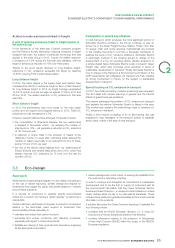APC 2012 Annual Report Download - page 66
Download and view the complete annual report
Please find page 66 of the 2012 APC annual report below. You can navigate through the pages in the report by either clicking on the pages listed below, or by using the keyword search tool below to find specific information within the annual report.
2012 REGISTRATION DOCUMENT SCHNEIDER ELECTRIC64
SUSTAINABLE DEVELOPMENT
2SCHNEIDER ELECTRIC’S COMMITMENT TO ENVIRONMENTAL PERFORMANCE
Action plans
The 2012-2014 company program includes the following objectives:
•reduction of energy consumption by 10% over three years
compared to2011;
•reporting of energy bills and roll-out of the StruxureWare Resource
Advisor software for all sites with more than 5,000m²;
•roll-out of StruxureWare Energy Operation at those sites for real-
time monitoring;
•certifi cation of energy management systems pursuant to the
ISO50001 standard for 20sites;
•identifi cation of opportunities to reduce energy consumption over
all sites as a result of the Energy Action audits.
The Schneider Energy Action program uses Schneider Electric
energy service activities to identify opportunities in key areas which
are HVAC (Heating, Ventilation, and Air Conditioning), certain
equipment (such as air compressors), lighting and specifi c industrial
processes.
Many initiatives and awareness campaigns are implemented
internally to improve understanding of the short and long term
benefi ts of energy effi ciency. There is also a dedicated Intranet site
that provides information on progress and the results obtained as
part of Schneider Energy Action.
The program resulted in the following achievements in2012:
•adjusted energy savings of 6.1% compared to2011 (climate and
industrial businesses) for the 100 highest-consumption sites;
•connection of 148sites to Struxureware Energy Operation;
•connection of 202sites to Struxureware Resource Advisor;
•ISO50001 certifi cation of 36sites;
•at the 100 highest-consumption sites, an energy manager and
an energy reduction action plan;
•around EUR3 million invested in energy effi ciency projects,
generally with a return on investment of less than three years.
Energy Operation and Resource Advisor are software suites that
are part of the Schneider Electric StruxureWare platform, which
helps customers in any market segment and across all geographic
areas to maximize their business performance while conserving
their resources, including energy. Energy Operation is applied at the
operations level and Resource Advisor is applied at the company
level.
Resource Advisor is Schneider Electric’s enterprise-level
StruxureWare software application and part of the EcoStruxure
architecture. Resource Advisor provides secure access to data,
reports and summaries to drive energy and sustainability programs.
Energy Operation is Schneider Electric’s operations-level
StruxureWare software application, part of EcoStruxure. Energy
Operation provides a data visualization and analysis application that
aggregates volumes of raw energy data into actionable information.
As a cloud-based software as a service (SaaS) model, it gives
reduced solution cost, increased data storage capacity, and a very
fl exible and mobile energy solution enhanced by Schneider Electric
expert services.
Examples
Implementing our own solutions, we have transformed our Pisek
manufacturing plant in the Czech Republic into an energy effi ciency
showroom, demonstrating our core strategy to customers and
employees. Thanks to Energy Action, the plant reached 24.5%
reduction in energy consumption in2012 vs.2008.
The Green IT program
Green IT is a program to reduce the electrical consumption of
Schneider Electric’s IT infrastructure (data centers, servers and
IT devices). It addresses all phases of the life cycle of IT devices
and involves a close partnership with our equipment and services
suppliers to reduce their carbon footprint.
The main objectives are:
•to optimize the number of data centers and their energy
management using Schneider Electric products and solutions;
•to ensure the continuous training of our IT teams, implementation
of continuous improvement plans and best practices to reduce
the use of electricity of all IT devices from the data centers to the
end user.
The following measures were implemented in2012:
•roll out of a Green IT confi guration for more than 15,000PCs,
providing a 20% reduction in power consumption and saving
more than 850MW per year;
•improvement of the PUE (Power Usage Effectiveness) from1.2
to1.08 for the Swindon (UK) data center, which hosts three of
our SAP platforms;
•consolidation in North America of 400servers in the Lexington
data center to the St. Louis data center on a Vblock virtual farm,
optimized infrastructure for the consolidation of data centers
and cloud computing, allowing for storage savings of more
than 830MW per year; this experience will allow for signifi cant
further consolidation and virtualization in 2013, in order to go
from 80sites to 8sites with more than 30% reduction in power
consumption;
•major infrastructure study in the Asia-Pacifi c region targeting
the consolidation of more than 200sites into 28sites, and 78%
virtualization in2013;
•major infrastructure study in China with the construction of
a “green” data center for a reduction of 70% in the number of
physical servers and energy savings of 40%; the project was
launched in2012 with plans for completion in2014;
•launch of Green IT awards in the Asia-Pacifi c region; roll-out
of the “my carbon footprint awareness” and “going lean and
optimization practical classes” programs in order to implement
Wake-on-LAN (WoL, an Ethernet network standard that allows a
computer to be booted from a distance), optimize the power of
PCs and screens and increase the ambient temperature of the
server rooms.
























